- Details
- Written by Gordon Prentice
On 28 November 2016 councillors are being recommended by Town staff to give approval to Bob Forrest's seven storey condo in the heart of the old downtown's Heritage Conservation District. (HCD)
They should say no.
Emphatically.
It they accept the recommendations of their planning staff they will be are relying on a lacuna in the law - and some fancy footwork - to subvert the intention of the Town's own Heritage Conservation District Plan.
It is a truly bizarre state of affairs.
Staff are recommending:
"Council pass a by-law that imposes a height maximum of 5 storeys on Main Street and 7 storeys on Park Avenue including the discussed step backs and design materials."
They can only do this because the Clock Tower lands are temporarily - and, perhaps, even permanently - outside the HCD with its three storey height cap for new developments within its boundaries. 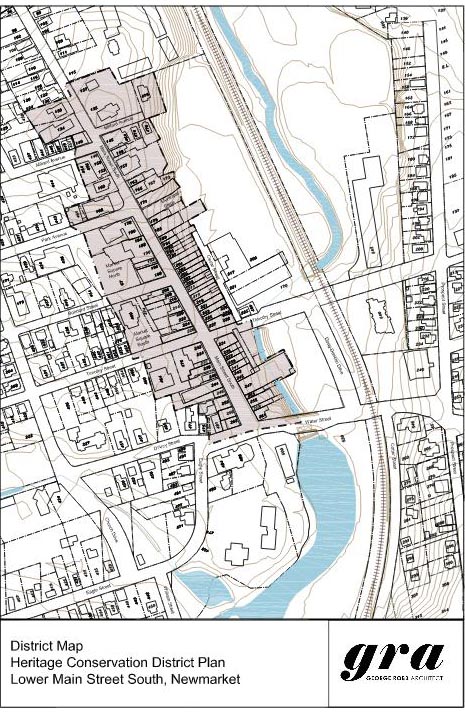
Forrest argues that his Clock Tower lands lie outside the HCD.
He argues that the HCD By-law was enacted by the Town in October 2013. (It put into by-law form the 2011 Heritage Conservation District Plan and did not add or subtract anything from that Plan.)
But Forrest says his completed application to redevelop the Clock Tower lands was formally submitted to the Town in August 2013 - a few months before the By-law was passed. He appealed to the OMB arguing his lands should remain outside the scope of the by-law with its three storey maximum.
His lawyer, the inventive Ira Kagan, said Forrest's application should be judged against the policy regime in place at the time it was submitted.
The OMB ruled that the Heritage Conservation District Plan should be brought into effect from 21 October 2013 except for the Forrest lands and until such time as Forrest's OMB appeal was heard and decided.
Without Forrest's appeal to the OMB, any development higher than the 3 storey maximum for new development in the area would have been prohibited by section 41.2 of the Ontario Heritage Act.
If Forrest gets the go-ahead on 28 November he can be expected to withdraw his OMB appeal. He will have what he always wanted. A giant out-of-place, disfiguring condo in the heart of the Town's heritage "conservation' district.
And the Town of Newmarket will have been his accomplice.
This email address is being protected from spambots. You need JavaScript enabled to view it.
The Ontario Heritage Act says:
"Consistency with heritage conservation district plan
41.2 (1) Despite any other general or special Act, if a heritage conservation district plan is in effect in a municipality, the council of the municipality shall not,
(a) carry out any public work in the district that is contrary to the objectives set out in the plan; or
(b) pass a by-law for any purpose that is contrary to the objectives set out in the plan.
Conflict
41.2 (2) In the event of a conflict between a heritage conservation district plan and a municipal by-law that affects the designated district, the plan prevails to the extent of the conflict, but in all other respects the by-law remains in full force."
Update on 21 November 2016: On 30 April 2013 I urged Tony Van Bynen to bring in the Heritage Conservation District By-law. Enact it now. Not when it is too late to matter. The Council enacted the By-law on 21 October 2013.
- Details
- Written by Gordon Prentice
Canada's greatest Main Street can expect construction turmoil and mayhem for years if Bob Forrest's seven storey condo gets the go ahead on 28 November 2016. 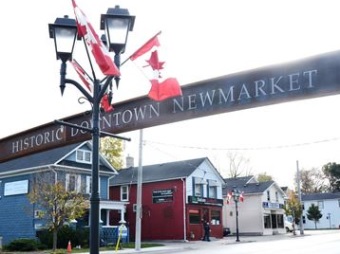
If Newmarket councillors accept the recommendations of their own planners to allow a giant apartment block in the very heart of the Town's Heritage Conservation District it will be an act of unparalleled civic vandalism.
Treasured historic buildings will be demolished including one at 184 Main Street South which dates from the mid 1840s. It was from here that Mary Anne Simpson, Ontario's first female pharmacist, operated an apothecary. We are told the facades of the doomed historic commercial buildings will be retained if possible.
If Forrest gets the green light to redevelop, councillors will be shredding their own Heritage Conservation District Plan, agreed in 2011, and, with it, the By-law passed in 2013.
Cut and Paste
The report from the Town's planners is a curiously limp and half-hearted affair. (scroll to agenda item 24) There are slabs of text lifted straight from Provincial Policy Statements and other official documents but relatively little in the way of commentary. It is a cut and paste job.
The recommendations from the Newmarket Heritage Advisory Committee which was against the Forrest application are set out without comment, context or explanation. Councillors are simply advised they must take them into consideration before making a decision on the proposal.
The authors of the report describe it as comprehensive. It is anything but. It doesn't address all the issues that were raised by the public who wrote in to the Town Hall or spoke at the Statutory Public meeting in May 2016. Many important issues such as the impact of construction, garbage removal and servicing the proposed retail units are left to another day.
Accommodating the developer
The report tries to reconcile two different but not necessarily mutually exclusive objectives: (a) getting more people living in the old downtown and (b) protecting the integrity of the Heritage Conservation District. The latter lost out in a big way. The authors of the report have bent over backwards to accommodate the developer, recommending everything Forrest needs to get the project off the ground. Even the so-called land swap.
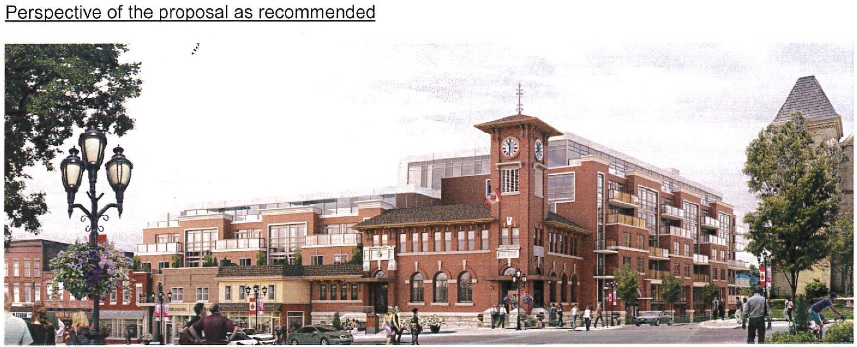
The report says:
"... recognising competing interests, the positive attributes of the proposal and comments from professional heritage planners, staff support greater development on a scale that would not negatively impact the heritage attributes of the district."
Staff want a new by-law that would allow five storeys instead of three on Main Street and seven on Park Avenue with step backs. Personally, looking at the graphics, I think this will have a huge impact on the look and feel of Main Street.
Demolition: when it's gone it's gone
The three historic commercial buildings south of the Clock Tower and owned by Forrest are to be demolished but next to no consideration has been given to their architectural or historic merits. The cursory peer review by ERA Architects did not even address the issue even though they were obliged to do so under the terms of their contract with the Town. 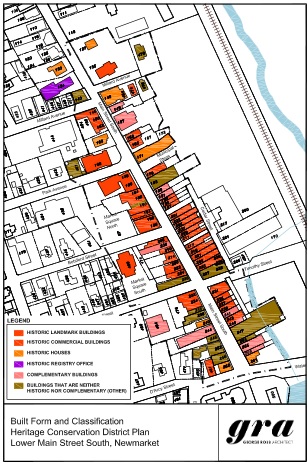
The report (page 3) refers to the proposed land swap without indicating if it is a fair exchange. Certainly the swap allows the development to proceed but, other than that, it is hugely lop-sided. The Town would be giving a large amount of land to the developer for his underground parking garage but getting next to nothing in return. The underground car park has no public spaces whatsoever.
Places to Grow
In this section we read about the Province's Growth Plan and the need for municipalities to "cultivate a culture of conservation". In the Animal Farm that is Newmarket Council, words end up meaning the exact opposite of what you might expect. "Conservation strategies" describe demolition.
Now the report morphs into a solid indigestible slab of text from the Provincial Policy Statement of 2014. We are told
"The PPS is meant to be read in its entirety and no one section of the PPS overrides others."
After wading through the waffle, we get to this little gem:
"The PPS would consider the Lower Main Street South Heritage Conservation District a Significant Cultural Heritage Landscape that must be conserved."
If Forrest's development were to go ahead as proposed it would have big negative impacts. So, rather than throw it out, the planners see how they can make it work. They pose the question:
"Can the Provincial goal of intensification be achieved while meeting the provincial goal of heritage conservation?"
But earlier we were told the proposed development
"is not required for the Town to meet the intensification targets set..."
Now we are reading more planning-babble from the York Region Official Plan. This stuff is painful to read but we've gotta press on.
Density is way over the top
Now the Town's planners are on to Newmarket's Official Plan. They focus on density and scale and such matters. We learn:
"The Historic Downtown Centre designation permits a number of uses including residential uses up to 80 units per net hectare. The Official Plan allows for greater densities provided background studies demonstrate that the proposed development will not create an unacceptable level of traffic and will be compatible with the existing surrounding development."
The density Forrest wants comes in at 430 units per net hectare and an FSI of 2.9. This blows apart the density standards for the old downtown which stipulate an FSI of 1.0
Parking
The current Town By-law requires 289 spaces for the proposed 165 apartment units. Forrest wants 199 spaces. The planners agree with Forrest, calling in aid yet another "peer review" this time from WSP Canada Inc. The parking spaces per resident go down from 1.5 to 1.2.
Heritage Impact
At long last we come to pages 10-20 of the report which look at the heritage impact of Forrest's proposal. We are told:
"... the proposal does not meet (the) policies of the Heritage Conservation District Plan by exceeding the 3 storey height recommendation for new construction within the district."
and
"To assist in the on-going review of the application against the HCD Plan (Heritage Conservation District Plan), a Heritage Impact Assessment (HIA) has been submitted and peer reviewed."
The HIA was commissioned and paid for by the developer and concluded that although Forrest's development did not meet the HCD Plan in terms of height restrictions it could, nevertheless, be mitigated to allow the Town to meet other planning goals in the historic downtown core. The HIA was peer reviewed by ERA Architects. It is useless. Yet the Town's planners' report does not point to any of its inadequacies.
ERA proposed 8 storeys on Park Avenue - or as they say in their report "Park Street". Newmarket staff regarded this as excessive and, as we know, settled on seven.
I have very little that is positive to say about ERA Architects but they do get a pat on the back for mentioning their concerns about the proposal altering the current skyline "which is a described heritage attribute" set out in paragraph 2.3.8 of the Heritage Conservation District Plan:
"Panoramic views of the district from outside the district's boundaries are valuable to the entire Historic Downtown Centre and include... the view from the southwest corner of Water and Prospect streets, looking northwest and featuring the four historic landmark buildings."
Now I am learning more about the staff's position. First, they say they would go for four storeys on Main and six on Park Avenue but, after thinking about those "competing interests" again, they settle on five and seven. They say the seven storey massing on Park is OK because it is off Main Street. But the Heritage Conservation District boundary (three storeys) extends along Park Avenue to Forrest's property line. It's all three storeys. Or was. 
Shafted
The treasured Heritage Conservation District is being shafted right, left and centre.
The Historic Downtown Urban Centre is zoned (UC-D1) where there is a minimum height of two storeys and a maximum of three. The planners want step-backs on Main Street and a fully glazed fifth storey. The original Forrest application, which the planners are now amending, proposed step-backs along the Main Street frontage. The staff report these would
"... give some distinction to a Main Street facade of two storeys however floors above the second will remain visible and could have impact on the heritage character of the area." (My underlining)
Adamantly recommend
Now we are on to the important contribution the Newmarket Heritage Advisory Committee made to the debate.
They "adamantly recommend" the Council to reject the Forrest proposal. But that statement was made before the Town's own planners got to work on Forrest`s application, coming up with recommendations making it more palatable to the Council.
There is no commentary from the Town's planners although they pick up elsewhere in the report the concerns the Advisory Committee had about the re-zoning being "precedent setting". Apparently, precedents don't come into the equation.
"With regards to the idea that if this proposal is approved, it will set a precedent for development of other properties on Main Street, any application for land use amendment is judged on its own merits. Future applicants would be required to make a complete application and provide the necessary justification for any proposal."
Fraudulent and phoney
This is a perfect illustration of a planning system which is totally fraudulent and phoney.
Three storeys never means three. And five may never mean five. It is all capricious.
We have a section on economic development penned by the Town's economic development officer. He says nine new restaurants have opened in the last five years - to my mind hardly a sign that the area is down on its heels.
Water and sewage allocations
The Forrest condo has not been given, as yet, a servicing allocation. Until it can be hooked up to the water mains and sewage pipes it can't be built. And since water and sewage allocations are rationed until 2024 (when the Upper York Sewage Solutions project is commissioned) any allocations made to Forrest reduce the number of allocations available for developments in the Town's corridors which are earmarked for high density buildings and intensification.
And it is not clear if the Forrest condo will cost the Town any money. Engineering Services say they are willing to support the zone change provided there is a Hold in the Zoning By-law which would not be lifted:
"until such time as it is demonstrated that adequate downstream sanitary sewage capacity is available or acceptable arrangements have been made with the Town to carry out any downstream improvements deemed necessary to accommodate flows from this development."
There are other issues concerning remediation of the site which could also warrant a Hold. (That is, the development could not proceed as planned until the issues specified in the "Hold" have been resolved.) 
Community consultation
The report ends with a section on community consultation. Many of the comments wait to be addressed. If approval is given it will be conditional on certain things happening. People were concerned about damage to adjacent buildings. No need to worry says the Town's planners, Forrest will have to submit a heritage conservation plan or strategy which will detail demolition techniques.
"Where there is a common wall between two properties, an engineer's report is required detailing how the structural integrity of the remaining structure will be maintained during demolition."
Tell that to the owner of the Olde Village Free House at 196 Main Street who shares a common wall, cement pad and roof with 194 that Forrest wants to knock down.
The high water table - eight feet below the surface - is, apparently, nothing to worry about. And there are other matters too which are for another day.
What is perfectly clear is there is no community buy-in to what is being proposed.
Neither the Downtown Business Improvement Area Committee nor the Town`s Heritage Advisory Committee has had a chance to comment on the latest revised proposal, drafted by the Town`s own planners. They should have an opportunity to comment. As should the rest of us.
Councillors should throw out the recommendations and stoutly defend their own Heritage Conservation District Plan.
This email address is being protected from spambots. You need JavaScript enabled to view it.
Update on Saturday 19 November 2016: The heritage blogger, Dan Schneider, has commented on an important OMB case which may have relevance. It concerns the impact of a proposed development in Toronto on an adjacent heritage property. You can read the full OMB decision here.
Update on Sunday 20 November 2016: the section on set-backs in the paragraph headed "Shafted" has been amended to make clear the quotation refers to the Forrest application before the Town's planners amended it.
- Details
- Written by Gordon Prentice
The Town's Planning staff are recommending approval for Bob Forrest's condo in the heart of the Heritage Conservation District in Main Street. (See agenda items 3 and 24)

We are told Forrest's re-submitted planning application for a Zoning By Law amendment should be approved subject to various conditions.
The planners want the height of the development fronting on to Main Street to be pegged to five storeys including step backs and the height on Park Avenue, including steps backs, to be capped at seven storeys.
On the one hand the Town's planners cite Provincial policy which promotes the desirability of "residential dwellings in the downtown core" and on the other they conclude that "the massing and height of the proposed development... would be in conflict with the heritage attributes of the Heritage Conservation District.." 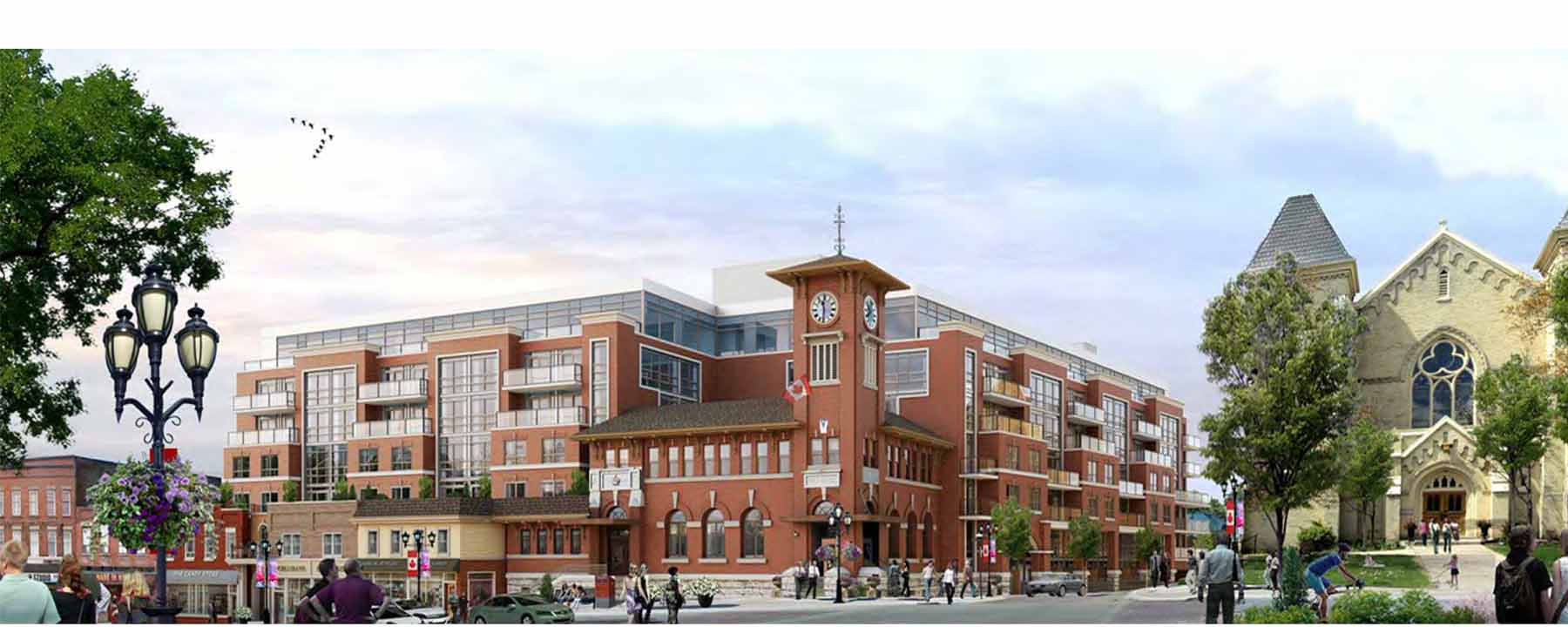
The recommendations from the planning professionals try to square the circle.
The Town's own planners have been working closely with the developer to come up with some kind of compromise.
The image at top reflects the planners' recommendation to councillors. The graphics would have been done by Bob Forrest's people.
A critique will follow.
This email address is being protected from spambots. You need JavaScript enabled to view it.
updated on 17 November to include images and further commentary.
- Details
- Written by Gordon Prentice
It is now official. Newmarket's historic Main Street is one of the great places in Canada according to the Canadian Institute of Planners.
I have a strange love/hate relationship with professional planners who, too often, are the handmaidens for brutal and inappropriate development. But this time, they have come up smelling of roses. 
The big question in my mind is whether this prestigious accolade will change the mindset of Newmarket's Mayor, Tony Van Bynen, who wants to see the demolition of historic commercial properties and the construction of a seven storey apartment building in the heart of the old Main Street.
In the CTV news clip aired last night Van Bynen waxes lyrical about the attractions of Main Street.
I listened carefully to His Worship but didn't hear him say he was planning to make it even greater by knocking down some fusty old historic buildings and replacing them with a gleaming giant out-of-place seven storey block!
All across Ontario the character of many fragile historic Main Streets is being transformed out of all recognition. In Meaford, for example, a new five storey 52 unit condo is going to change the look and feel of this historic row of buildings even though some facades are to be preserved. 
But we shouldn't have to be grateful for small mercies. If something is worth saving we should say so, loud and clear, and face down the developers and those who help them destroy irreplaceable historic buildings and unmatched views and panoramas.
The Town's Committee of the Whole will consider Bob Forrest's Clock Tower application on Monday 28 November 2016 at 7pm at 395 Mulock Drive.
The planners' report with their recommendations will be available on the Town website this Friday (18 November 2016).
I shall be posting a critique here on ShrinkSlessorSquare.ca
This email address is being protected from spambots. You need JavaScript enabled to view it.
Town of Newmarket planner Adrian Cammaert nominated Main Street for the award. Good on him.
Details of the Great Places in Canada awards can be found here. The CTV video can be accessed via:
CityNews Toronto (@CityNews) tweeted at 11:03 PM on Tue, Nov 15, 2016:
Newmarket wins people’s choice award for greatest main street in Canada https://t.co/qd8cYEGr5O
(https://twitter.com/CityNews/status/798738292489547776?s=02)
- Details
- Written by Gordon Prentice
In April 2015 the City of Vaughan decided to dock Regional Councillor Michael Di Biase's pay for 90 days on the grounds that he had improperly interfered in the Council's tendering processes. The decision followed a report from the City of Vaughan's Integrity Commissioner who is independent. 
Di Biase cried foul and protested his innocence.
He said he would challenge the decision in Court.
The matter came before the Assistant Chief Justice of the Superior Court of Ontario, Frank Marrocco, and two of his fellow judges, Carolyn Horkins and Michael Varpio.
Judgement was handed down on 19 September 2016 with the Court dismissing Di Biase's arguments saying
"There is no merit in any of the applicant's (Di Biase) submissions."
The Court observed:
"The maximum penalty that may be imposed by the Council is a suspension of pay for 90 days. The applicant cannot lose his elected position, and the Integrity Commissioner cannot make the applicant civilly liable.
The decision is important to the applicant because it affects his reputation."
Di Biase serves on two municipalities; his home City of Vaughan and York Regional Council.
While Di Biase forfeited his City of Vaughan salary for 90 days he continued to claim his full salary from York Region. In 2015 he received $54,071 in salary plus $8,949 in benefits and $2,104 in expenses from the Region.
The report from the Integrity Commissioner which triggered this series of events makes jaw-dropping reading.
At the time I called on Biase to volunteer to give up three month's pay from York Region and stand down as Chair of Planning and Economic Development on the grounds that his integrity and impartiality had been totally compromised.
Blind eye
Biase's colleagues on the Regional Council turned a blind eye to his transgressions.
They felt able to do this because, astonishingly, the Regional Council has no Code of Conduct for its members. And without a Code of Conduct there is no need for an Integrity Commissioner.
At their meeting in October 2015, members decided that a Regional Code of Conduct wasn't needed.
Michael Di Biase is clearly the wrong person to be chairing Committee of the Whole meetings when far-reaching planning and development issues are considered.
But will anyone on York Regional Council do something about it?
Don't hold your breath.
This email address is being protected from spambots. You need JavaScript enabled to view it.
Note. This blog was amended today (14 November 2016) to make it clear that York Region has a Committee of the Whole structure in which Planning and Economic Development matters are put forward by the Chair, Michael Di Biase, to the Committee for its consideration and decision.
Page 189 of 286